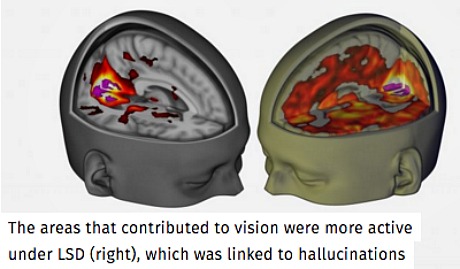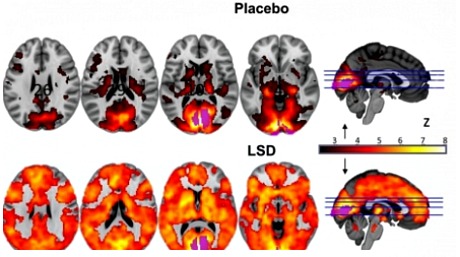I’ve made it quite clear in this column that I wouldn’t touch LSD (lysergic acid diethylamide) these days with a 10-foot pole. But back when I used to touch it I would always describe what it did to my brain as a kind of blissful washover that freed me from everything I’d learned in school and thereby delivered radiant truths. The usual mental associations and thought patterns were rescrambled by my senses turning all tingly and Technicolored — an elevator-in-the-brain-hotel sensation leading to heightened sensitivity, receptivity. Which led to the opening of Dr. Huxley‘s doors of perception and the gates of prana, satori, nirvana.

Four or five days ago researchers from London’s Imperial College, working with the Beckley Foundation, published for the first time in the history of LSD visual records that precisely show the effects of the drug on the brain. Here’s a PDF with the findings.
The team administered LSD to 20 “healthy” volunteers and then used various brain-scanning techniques to visualize how LSD alters the way the brain works. For the first time in history the images depicted the ch-ch-ch-ch-changes that that people have sought to verbally describe for decades.
Dr. Robin Carhart-Harris, from the Department of Medicine at Imperial: “Normally our brain consists of independent networks that perform separate specialized functions, such as vision, movement and hearing — as well as more complex things like attention. However, under LSD the separateness of these networks breaks down and instead you see a more integrated or unified brain.
“Our results suggest that this effect underlies the profound altered state of consciousness that people often describe during an LSD experience. It is also related to what people sometimes call ‘ego-dissolution’, which means the normal sense of self is broken down and replaced by a sense of reconnection with themselves, others and the natural world.
“This experience is sometimes framed in a religious or spiritual way, and seems to be associated with improvements in well-being after the drug’s effects have subsided.”
Posted on 6.6.15: Hallucinogens changed everything in this country, specifically during a six- or seven-year period from the mid ’60s to early ’70s. Hallucinogens suddenly made traditional Christian beliefs seem primitive and old-hat, ignited interest in Eastern mysticism and transcendental meditation, and brought about “The Me Decade and the Third Great Awakening,” as Tom Wolfe famously called it.
LSD really did bring about a profound social rapture. It opened things way, way up for Aldous Huxley, Cary Grant and other Los Angeles devotees in the ’50s, some members of the Harvard University faculty in the early ’60s, the more adventurous rock-music artists of the mid to late ’60s (including Brian Wilson and the Beatles), and God knows how many thousands who followed in their wake. It gave everyone with any kind of devotional attitude a taste of the mystical and sublime, the kind of Eastern enlightenment God-head that had previously been known only to a select few over the centuries.
It’s all laid out in Jay Stevens‘ “Storming Heaven,” a book I’ve written about three or four times before. “Elevator in the brain hotel” is great, but there’s SO MUCH MORE to be had from that drug…words fail. One thing you have to conclude at the end of the day is that in the broader context of 20th Century spiritual seeking, the words “don’t take drugs…drugs are bad for you” fail to address the profound.
Am I suggesting to anyone who may be reading this column that they should drop LSD? No, I am not. At this stage in my life I would rather face a platoon of ISIS psychos than take another acid trip, but man, when I went there in my 20s it was a symphony of beauty, bliss, rapture and serenity like something I’d never known, and will never, ever forget.

